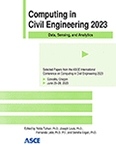The Importance of Situational Awareness in Future Construction Work: Toward the Effects of Faulty Robots, Trust, and Time Pressure
Publication: Computing in Civil Engineering 2023
ABSTRACT
Introducing robots to future construction sites will impose extra uncertainties and necessitate workers’ situational awareness (SA) of them. While previous literature has suggested that system errors, trust changes, and time pressure may affect SA, the linkage between these factors and workers’ SA in the future construction industry is understudied. Therefore, this study aimed to fill the research gap by simulating a future bricklaying worker-robot collaborative task where participants experienced robot errors and time pressure during the interaction. The results indicated that robot errors significantly impacted subjects’ trust in robots. However, under time pressure in time-critical construction tasks, workers were tended to recover their reduced trust in the faulty robots (sometimes over-trust) and reduce their situational awareness. The contributions of this study lie in providing insights into the importance of SA in future jobsites and the need for investigating effective strategies for better preparing future workers.
Get full access to this article
View all available purchase options and get full access to this chapter.
REFERENCES
Abd, M. A., Gonzalez, I., Nojoumian, M., and Engeberg, E. D. (2017). “Trust, satisfaction and frustration measurements during human-robot interaction.” In Proceedings of the 30th Florida Conference on Recent Advances in Robotics May 11-12.
De Visser, E. J., Peeters, M. M., Jung, M. F., Kohn, S., Shaw, T. H., Pak, R., and Neerincx, M. A. (2020). “Towards a theory of longitudinal trust calibration in human–robot teams.” International journal of social robotics, 12(2), 459–478.
Demir, M., McNeese, N. J., Gorman, J. C., Cooke, N. J., Myers, C. W., and Grimm, D. A. (2021). “Exploration of teammate trust and interaction dynamics in human-autonomy teaming.” IEEE transactions on human-machine systems, 51(6), 696–705.
Endsley, M. R. (1988). “Design and evaluation for situation awareness enhancement.” In Vol. 32 of Proc., Human Factors and Ergonomics Society Annual Meeting, 97–101. Los Angeles, CA: SAGE Publications.
Hancock, P. A., Billings, D. R., Schaefer, K. E., Chen, J. Y., De Visser, E. J., and Parasuraman, R. (2011). “A meta-analysis of factors affecting trust in human-robot interaction.” Human factors, 53(5), 517–527.
Hasanzadeh, S., Esmaeili, B., and Dodd, M. D. (2018). “Examining the relationship between construction workers’ visual attention and situation awareness under fall and tripping hazard conditions: Using mobile eye tracking.” Journal of construction engineering and management, 144(7).
Jeelani, I., and Gheisari, M. (2022). “Safety challenges of human-drone interactions on construction jobsites.” Automation and robotics in the architecture, engineering, and construction industry, 143–164.
Kaber, D., Jin, S., Zahabi, M., and Pankok, C. (2016). “The effect of driver cognitive abilities and distractions on situation awareness and performance under hazard conditions.” Transp. Res. Part F Traffic Psychol. Behav. 42 (1): 177–194.
Kunze, A., Summerskill, S. J., Marshall, R., and Filtness, A. J. (2019). “Automation transparency: implications of uncertainty communication for human-automation interaction and interfaces.” Ergonomics, 62(3), 345–360.
Lu, Y., and Sarter, N. (2020). “Modeling and inferring human trust in automation based on real- time eye tracking data.” Proceedings of the Human Factors and Ergonomics Society Annual Meeting, 64(1), 344–348.
Lu, Z., Guo, J., Zeng, S., and Mao, Q. (2020). “Research on Human-machine Dynamic Trust Based on Alarm Sequence.” In Proceedings of the 2nd World Symposium on Software Engineering (pp. 314–320).
Muir, B. M. (1994). “Trust in automation: Part I. Theoretical issues in the study of trust and human intervention in automated systems.” Ergonomics, 37 (11): 1905–1922.
Nepal, M. P., Park, M., and Son, B. (2006). Effects of schedule pressure on construction performance. Journal of Construction Engineering and Management, 132(2), 182–188.
Pooladvand, S., and Hasanzadeh, S. (2022). “Neurophysiological evaluation of workers’ decision dynamics under time pressure and increased mental demand.” Automation in Construction, 141, 104437.
Robinette, P., Howard, A. M., and Wagner, A. R. (2017). Effect of robot performance on human–robot trust in time-critical situations. IEEE Transactions on Human-Machine Systems, 47(4), 425–436.
Salem, M., Lakatos, G., Amirabdollahian, F., and Dautenhahn, K. (2015). “Would you trust a (faulty) robot? Effects of error, task type and personality on human-robot cooperation and trust.” In Proceedings of the tenth annual ACM/IEEE international conference on human-robot interaction (pp. 141–148).
Wickens, C. D. (2005). “Attentional tunneling and task management.” In 2005 international symposium on aviation psychology (p. 812).
Wickens, C. D., McCarley, J. S., Alexander, A. L., Thomas, L. C., Ambinder, M., and Zheng, S. (2008). Attention-situation awareness (A-SA) model of pilot error. Human performance modeling in aviation, 213–239.
Information & Authors
Information
Published In
History
Published online: Jan 25, 2024
ASCE Technical Topics:
- Automation and robotics
- Bibliographies
- Business management
- Construction engineering
- Construction industry
- Construction management
- Construction sites
- Continuum mechanics
- Dynamics (solid mechanics)
- Employment
- Engineering fundamentals
- Engineering mechanics
- Errors (statistics)
- Information management
- Labor
- Mathematics
- Motion (dynamics)
- Personnel management
- Practice and Profession
- Solid mechanics
- Statistics
- Systems engineering
- Uncertainty principles
Authors
Metrics & Citations
Metrics
Citations
Download citation
If you have the appropriate software installed, you can download article citation data to the citation manager of your choice. Simply select your manager software from the list below and click Download.
